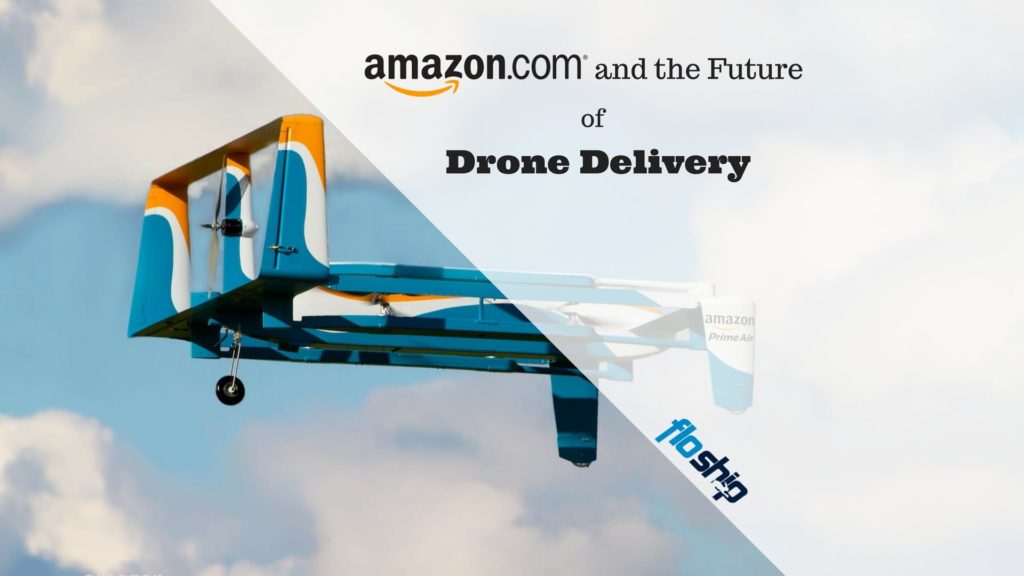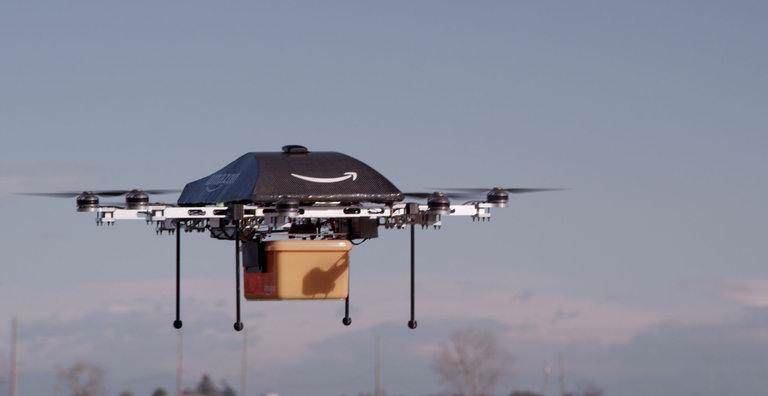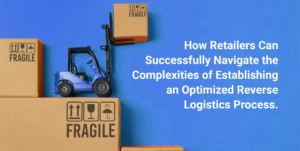The Amazon Drones Are Coming
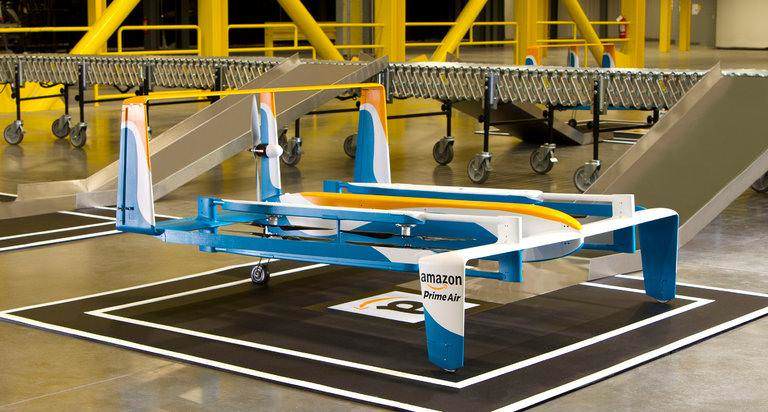
Since its founding in 1994, Amazon has been massively disrupting the retail world. Over the years, they’ve increased their delivery speed to the point where they now offer free 2-day shipping with Amazon prime. They are also beginning to push their on-call delivery service, Prime Now, which is currently available in 20 metro areas.
According to Motley Fool:
Amazon’s fastest order delivered to date was a four-pack of Starbucks vanilla Frappuccino to a customer in Miami. The delivery was made in under 10 minutes.
For several years now, Amazon has also been indicating that they intend to begin using drones to deliver products. Founder Jeff Bezos said back in 2013, “One day, Prime Air vehicles will be as normal as seeing mail trucks on the road today.”
Here’s the original Prime Air promo video:
But even though Amazon has been discussing drone delivery for upwards of three years now, they still have not put the program into action.
What will the future of drone delivery look like for Amazon?
It’s hard to know precisely because the company is notoriously secretive. However, we can make some educated guesses based on the actions of the company, the current state of drone use in the United States, and general market conditions.
Here’s what we currently know and where we think things may be headed.
Amazon Is Rapidly Expanding Its Delivery Methods
Amazon clearly has plans to massively expand their delivery operations, and drones are only a small part of those plans.

Image via WSJ.com
The Wall Street Journal reports:
Amazon.com plans to roll out thousands of branded semi-trucks to help shuttle inventory between its facilities, an effort to take more control of its shipping processes.
Additionally, Amazon is using a crowdsourced delivery method and is building a fleet of airplanes to supplement the standard delivery options they currently use. Clearly, they are intent on using all the resources at their disposal to significantly decrease the time between an order being placed and the package actually being delivered.
Some think that Amazon is trying to completely replace the third-party companies, such as UPS and FedEx, that is uses for delivery. This probably isn’t the case. As the New York Times reports:
…[Amazon’s] not trying to replace third-party shippers. Instead, over the next few years, Amazon wants to add as much capacity to its operations as possible, and rather than replace partners like UPS and FedEx, it is spending boatloads on planes, trucks, crowdsourcing and other novel delivery services to add to its overall capacity and efficiency.
Wal-Mart recently purchased Amazon competitor Jet.com for $3.3 billion, ratcheting up the online selling competition between Amazon and Wal-Mart. By continuing to increase their delivery speed, Amazon can gain a competitive advantage over ecommerce rivals.
Additionally, by using drones, Amazon can completely eliminate many of the issues that come with traditional delivery methods. Instead of relying on human delivery, which is prone to be late or incorrect, drone delivery can be controlled directly by Amazon itself. Again, quoting the New York Times:
When I began talking to others in the drone industry about Amazon’s interest in autonomous flight, they all pointed out that drones offer a way to leapfrog roads. Because they operate in a new, untrammeled layer of physical space — below 400 feet, an airspace that is currently unoccupied in most of the country — they open up a vast new shipping lane.
Opening up these new shipping lanes is crucial for ecommerce stores like Amazon.
The U.S. Department of Transportation has warned that the current infrastructure in the United States isn’t sufficient. They predict that, unless something changes, U.S. roads will become terribly clogged by 2040, which would be a disaster for Amazon. Clearly, Amazon needs to create alternative shipping methods to avoid this sort of disaster.
Amazon Must Clear Regulatory Hurdles Before Using Drones
Image via Amazon.com
Technology is not the primary hurdle Amazon must clear in implementing Prime Air. In fact, many experts believe Amazon already has all the necessary technology in place. Other companies, such as Chipotle and Alphabet (Google’s parent company) are already experimenting with drone delivery.
As The Verge recently reported:
Google parent company Alphabet is teaming up with fast casual chain Chipotle to test drone delivery for Virginia Tech students, according to a report from Bloomberg. The pilot program marks a turning point for Alphabet’s Project Wing division, giving the team ample room to experiment with airborne burrito deliveries in one of the first commercial programs of its kind to be greenlit by the US Federal Aviation Authority.
The primary challenge is navigating the regulatory environment surrounding drone aviation:
The current drone regulations from the FAA are prohibitive to widespread commercial use, stating that commercial drone operators must always keep a drone within line of sight, which prohibits use for commercial delivery.
These current regulations are why Amazon is spending millions of dollars every year lobbying the government for friendlier regulations.
Given the current regulations and level of opposition to commercial drone flight, it will probably be some time before Prime Air becomes a reality.
However, given the number of companies currently investing in drones, it seems inevitable that drone deliveries will happen. It’s only a matter of time.
Amazon Is Testing A Variety Of Drones In A Variety Of Locations
True to form, Amazon has not been especially forthcoming about the nature of their drone program. We do know that Amazon is testing drones in Britain, which has more favorable drone regulations.
As Cecilia Kang reported:
Britain’s aviation regulator will let Amazon test several aspects of drone technology — such as piloting the machines beyond the line of sight of its operators — that the Federal Aviation Administration in the United States has not permitted. The tests, which are an important sign of confidence in Britain after its historic vote last month to leave the European Union, are to begin immediately.
The company is also testing drones in Canada, the Netherlands, and Israel.
Until the United States loosens drone regulations, it seems likely that most of their testing will happen outside the borders. It also seems feasible that drone delivery could be implemented in other countries before coming to the United States.
We also know that Amazon is testing a variety of drone designs.
On their website they show two different designs, and it seems likely that they will continue to iterate the design until they reach the ideal blend of speed and cost.

As they state on their site:
We are testing many different vehicle designs and delivery mechanisms to discover how best to deliver packages in a variety of environments. We have more than a dozen prototypes that we’ve developed in our research and development labs. The look and characteristics of the vehicles will evolve over time.
Initial Rollouts Will Probably Be In Medium To Low Density Areas
Because of the space needed to deliver via drone, it seems likely that Prime Air will initially be rolled out in more spacious areas, with low to medium population density.
Those living in densely populated urban areas will probably need to wait until Amazon solves issues such as telephone wires, high-rises, and even drone jackers who will swipe packages.
As Digital Spy reports:
As the drones have to make a controlled landing in a nicely spacious area, city-dwellers and those of you in blocks of flats are going to have some issues. As well as obstacles such as telephone wires and narrow streets, the lack of a private landing area could prove problematic.
Amazon has indicated that those receiving drone deliveries will need to have a “landing mat” of sorts where the drone will land. This landing zone will be Amazon branded and will act as a homing beacon to guide the drone to the landing spot. It will be small and light, meaning it can be easily stored when not in use.
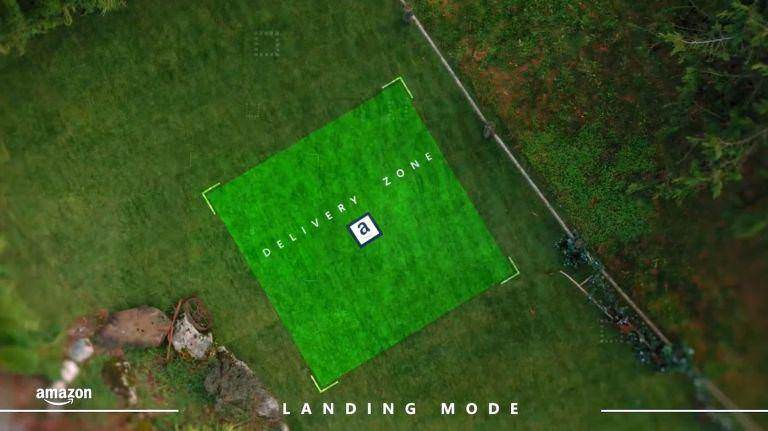
Amazon is claiming that Prime Air will decrease delivery times to as little as 30 minutes from the time of delivery. This dramatically shortened delivery time will make Prime Air often more convenient than going to the store.
Conclusion
Although Prime Air probably won’t be available in the United States for some time, we can be certain it will arrive.
Currently, the drone regulations are the main impediment to commercial drone delivery.
As companies like Amazon and Alphabet lean heavily on the United States government to loosen regulations, we can expect to see progress made. But until those regulations change, most of us will have to settle for free 2-day shipping, which isn’t such a bad option in the scheme of things.
Find out how to Automate your Amazon Order Fulfillment process with the Amazon + Floship Integration here!
Related E-commerce News and Posts
- Cross-Docking Forget Warehousing and Ship Efficiently
- What Is Fueling The eCommerce Boom In China?
- Scaling Shopify – 3 Winning Tools to Skyrocket Your Store
- E Fulfillment for Retailers Ship Worldwide

Ready To Upgrade Your Logistic Solution?
Speak to Floship ecommerce logistic consultant about improving your global support chain today

